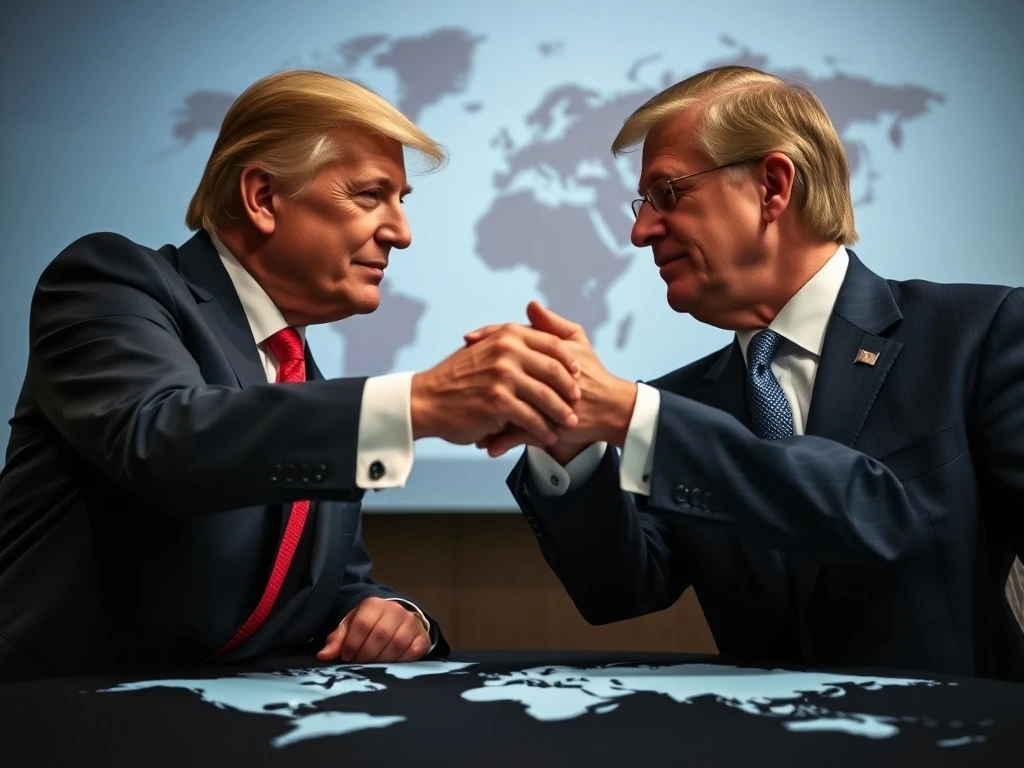Landmark US-EU Trade Deal: Averts 30% Tariffs, Boosts Global Market Confidence

Even in the fast-paced world of cryptocurrency, broader macroeconomic shifts can ripple through market sentiment. The recent US-EU trade deal is a prime example, bringing a sigh of relief to global financial markets and potentially paving the way for increased investor confidence across various asset classes, including digital assets. This landmark agreement, finalized on July 26, 2025, between the U.S. and the EU, successfully averted a threatened escalation of tariffs, settling instead on a more palatable 15% rate for most goods.
What Does the Landmark US-EU Trade Deal Entail?
The agreement, spearheaded by President Trump and European Commission President Ursula von der Leyen, marks a significant diplomatic victory. It pulls back from the brink of a potentially disruptive transatlantic trade war, which had seen threats of a steep 30% tariff rate looming since July 1.
- Averted High Tariffs: The deal successfully avoids the previously warned 30% tariffs on EU goods, a move that could have severely disrupted global supply chains.
- 15% Standard Rate: A 15% tariff rate will now apply to most EU goods, excluding automobiles, marking a crucial compromise.
- EU Commitments: The European Union has committed to purchasing $750 billion in U.S. energy and investing $600 billion in American markets. These commitments were central to the negotiation, as confirmed by von der Leyen.
How Will This Impact Markets? Exploring the Economic Impact and Investor Confidence
The announcement sparked cautious optimism across financial markets. Investors, relieved by the avoidance of a transatlantic trade war, saw modest gains in financial indices. This positive sentiment underscores the deal’s potential to foster greater market confidence.
- Potential Benefits:
- Boost to Key Sectors: The agreement is expected to bolster energy and industrial sectors on both sides of the Atlantic, driven by the EU’s substantial energy purchase and investment commitments.
- Reduced Uncertainty: A smoother trade path between the two largest trading partners reduces uncertainty, which historically correlates with bullish market conditions.
- Stimulated Growth: The deal has the potential to stimulate economic growth by fostering more predictable and stable trade relations.
- Challenges Remain: Despite the positive immediate reactions, challenges persist. Aligning regulatory frameworks and addressing long-standing disagreements over subsidies and market access will require ongoing collaboration.
Navigating Global Trade Tensions: A Broader Perspective
This agreement comes at a time of heightened global trade tensions worldwide. The U.S. and EU, as two of the world’s largest trading partners, play a pivotal role in shaping the international trade landscape. Resolving their disputes sends a positive signal.
- Implications for Global Trade:
- De-escalation Model: The successful resolution of this dispute could serve as a model for de-escalating other trade tensions globally.
- Supply Chain Stability: Averted high tariffs mean less disruption for global supply chains that rely on transatlantic trade flows.
- Diplomatic Success: The direct engagement between leaders highlights the importance of high-level diplomacy in resolving complex economic disagreements.
Beyond Tariffs: What’s Next for US-EU Trade Policy?
While the immediate focus is on the averted 30% trade tariffs and the new 15% rate, the agreement also outlines ongoing collaboration on trade enforcement and dispute resolution mechanisms. The long-term success hinges on several factors.
- Future Considerations:
- Commitment Fulfillment: The EU’s ability to meet its energy and investment commitments will be crucial for the deal’s lasting impact.
- Enforcement: The U.S. enforcement of agreed-upon trade practices will also be key to maintaining balance and trust.
- Regulatory Alignment: Continued efforts to align regulatory frameworks and address underlying trade imbalances will be necessary for sustainable cooperation.
- Job Creation: The White House projects the pact will create “millions of jobs,” reinforcing the economic rationale behind the agreement.
The landmark US-EU trade deal represents a significant step towards stabilizing transatlantic economic relations. By averting potentially damaging tariffs and establishing a clear path for future engagement, it not only provides immediate relief to markets but also sets a precedent for constructive dialogue in an increasingly complex global economy. While challenges remain, the agreement’s potential to foster growth and boost market confidence is undeniable, signaling a more predictable future for international commerce.
Frequently Asked Questions (FAQs)
What is the primary outcome of the US-EU trade deal?
The primary outcome is the agreement to set a 15% tariff rate on most EU goods, successfully averting the previously threatened 30% tariffs and de-escalating a potential transatlantic trade war.
What was the previous tariff threat, and what rate was agreed upon?
The U.S. had previously threatened to impose 30% tariffs on EU exports if no agreement was reached. The finalized deal sets a 15% tariff rate on most goods, excluding automobiles.
What are the EU’s key commitments in this agreement?
The EU has committed to purchasing $750 billion in U.S. energy and investing $600 billion in American markets, which were central to the negotiation.
How have financial markets reacted to the deal?
Market reactions have been cautiously optimistic, with financial indices showing modest gains as investors expressed relief at the avoidance of a transatlantic trade war, contributing to increased market confidence.
What are the long-term success factors for this trade agreement?
The long-term success of the deal will depend on the EU’s ability to meet its energy and investment commitments, as well as the U.S. enforcement of agreed-upon trade practices and ongoing efforts to align regulatory frameworks.
Does this deal affect cryptocurrency markets?
While not directly related to cryptocurrency, broad macroeconomic developments like this US-EU trade deal can positively influence overall investor sentiment and reduce global economic uncertainty, which can indirectly contribute to a more stable environment for all asset classes, including digital assets.








